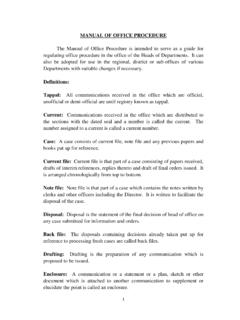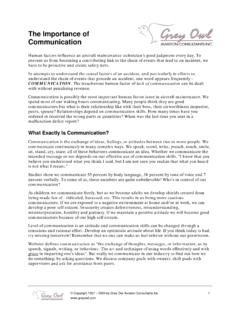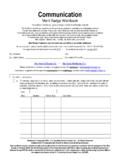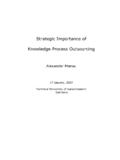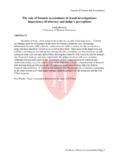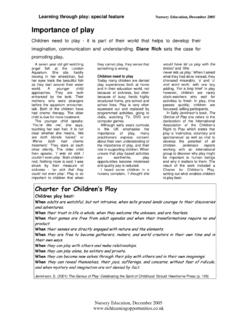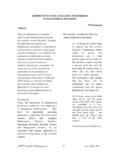Transcription of EFFECTIVE COMMUNICATION - IMG Kerala
1 EFFECTIVE COMMUNICATION . Meaning & importance The success of an individual in a team depends greatly on the extent to which he can engage in EFFECTIVE COMMUNICATION . Faulty COMMUNICATION in organizations can lead to lowered efficiency and effectiveness at the organizational as well as individual level. Also most of the interpersonal friction can be traced to faculty COMMUNICATION . COMMUNICATION , derived from the Latin word 'Communicare' which means to share; is the process of transmitting information and understanding.
2 It is the transference of meaning between individuals and the means of reaching, understanding and influencing others. Skill to communicate depends on the capacity of an individual to convey ideas and feelings to another to evolve a desired response. In management, COMMUNICATION is a mixture of personal attributes and organizational aspects. Good COMMUNICATION is necessary for all organizations as management functions in organizations are carried out through COMMUNICATION . EFFECTIVE management is a function of EFFECTIVE COMMUNICATION .
3 Interpersonal COMMUNICATION takes places every time we interact with others. COMMUNICATION is considered EFFECTIVE when it succeeds in evoking a desired response from the other person. Moreover failures in COMMUNICATION can be very costly for the organization by way of reduced co-operation and subsequent ill feeling between employees. COMMUNICATION , to be EFFECTIVE , cannot be a haphazard process. It has to be planned and executed so that it evokes the desired response. COMMUNICATION in organizations has the following role o Helps in fostering motivation o Aids in the function of control o Provides information for making decisions o Gives vent to one's feelings o Helps in the satisfaction of social needs PROCESS OF COMMUNICATION .
4 The process of COMMUNICATION between two individuals can be illustrated below: Encoding Channel Sender Message Receiver Feedback 1. COMMUNICATION is initiated by the sender who conceptualizes the idea that is to be transmitted. This idea is encoded with the help of language, symbols etc. into a message. The message, which is the product of encoding, is transmitted from the sender to the receiver through a channel. Channel or medium can be physical presence (face to face talk) interactive channels (telephone, electronic media) personal static channel (memos, letters) or impersonal static channels (general reports, circulars etc.)
5 The richness of each channel is determined according to its capability in eliciting feedback. Accordingly, face to face talk is considered richest and impersonal static channel is considered to be the leanest. However for making COMMUNICATION efficient, the sender has to choose the channel depending upon the urgency and complexity of the idea which is communicated. Once the message is transmitted through the channel to the receiver, he decodes it back to the idea and assimilates it. The effectiveness of COMMUNICATION depends upon the extent to which the sender has succeeded in making the receiver understand his idea.
6 This can be evaluated through feedback, where the receiver responds to the sender in the form of clarifications and doubts. Feedback, which makes COMMUNICATION two way is important because it helps to evaluate the effectiveness of the COMMUNICATION . ELEMENTS OF COMMUNICATION . Verbal COMMUNICATION Verbal COMMUNICATION (vocal included) contributes to 45% of our COMMUNICATION . It involves the use of language and meaning (either oral or written). Normally the words used in COMMUNICATION are concrete or abstract.
7 Concrete words represent an object (eg. Chair) and hence convey ideas easily. Abstract words, on the other hand, has a built-in- ambiguity because the ideas conveyed by such words are subjective and so effectiveness of COMMUNICATION is in question (eg. beauty, intelligence etc.). Thus, while concrete words can be compared to a sharp tool, abstract words are often compared to a blunt instrument. Role of jargons is also crucial in determining the effectiveness of COMMUNICATION . While jargons help to communicate easily in a homogeneous group, excessive use of there can hinder COMMUNICATION .
8 Use of jargons has to be minimized while communicating to someone who is not familiar with the terms. Verbal COMMUNICATION becomes EFFECTIVE through the choice of right words & emphasis of the same. There should be an optimum use of pauses, non-words and phrases because excessive use of these leads to distraction of the receiver. Non-verbal COMMUNICATION Non verbal COMMUNICATION is the conscious and unconscious body movements in COMMUNICATION that couple with physical and environmental surroundings. Non verbal communications are those which are not expressed orally or in writing and includes human elements associated with COMMUNICATION .
9 These form an important and inevitable 2. aspect of the total COMMUNICATION process because it compliments and substitutes verbal COMMUNICATION . A good communicator should have the right posture, facial expression and body language that are in tune with the words spoken. Lack of co-ordination between verbal and non- verbal contents of COMMUNICATION would only confuse the receiver. So while communicating, care should be taken to ensure a proper blend between words and actions. Listening & Feedback Listening which comprises of hearing, attending, understanding and remembering can facilitate the effectiveness of COMMUNICATION .
10 Listening can be pleasurable, discriminative or critical depending on the degree of application of mind. Listener has to employ the appropriate type of listening depending on the situation and nature of the message. Proper listening requires a reasonable background familiarity, right attitudes, interest, objectivity, patience and rapport with the sender. Absence of rapport with the sender often leads to ambush listening where the receiver listens only till he gets a point for argument after which his main intention would be to interrupt the COMMUNICATION .
